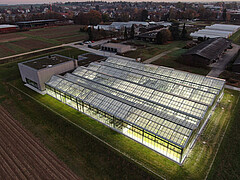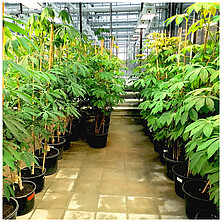Climate Research & Bioeconomy | + Video
New High-Tech Greenhouse [05.10.21]

The first part of the new high-tech research greenhouse Phytotechnical Center is located in the west of the University of Hohenheim campus. | Photo source: University of Hohenheim / Christian Trautmann
Although the first construction phase of the Phytotechnical Center was already put into operation in spring 2020, an inauguration ceremony had to be cancelled due to the Covid situation. This was made up for today with a ceremonial handover, to which guests from politics and science were invited.
The construction of the first phase of the new building was made possible thanks to a generous grant of four million euros, with which the Carl Zeiss Foundation co-financed the construction costs. A further 4.4 million euros were provided by the state of Baden-Württemberg, and 300,000 euros by the University of Hohenheim.
At the construction ceremony, University President Prof. Dr. Stephan Dabbert expressed his enthusiasm: "The Phytotechnical Center is a central building block for our most important research priorities and contributes to solving global human problems, such as food security and how agriculture can deal with the consequences of climate change."
Less water and less energy
Above all, the utilization concept has been well thought out: heating via a dedicated district heating network ensures a low energy balance, a planned photovoltaic system on the flat roof surfaces and energy screens inside the building reduce further energy losses. At a conservative estimate, the new research greenhouse should ultimately consume around two-thirds less energy per square meter. Roughly speaking, this could translate into a four-digit number of megawatt hours saved each year.
Added to this is a sophisticated water management system: rainwater that can no longer seep away at the site of the new building is captured by the university in its own cisterns so that it can be used to water the plants and cool the autoclave.
1,400 square meters of glass, including modern technology
Modular individual elements can be combined to form units of different sizes. Depending on experimental requirements, small and large units can be quickly interconnected to form chambers between 11 and 120 square meters, making research more flexible. "With these highly variable research units, the Phytotechnical Center is building a bridge between basic scientific research and practice," said President Prof. Dr. Dabbert with satisfaction.
Inside is state-of-the-art technology: computer-controlled climate control and automatic watering, fine regulation for light intensity, humidity, and temperature, and variable lighting technology, with a choice of mercury, sodium, or sulfur vapor lamps. "We can control each chamber individually and thus meet the wishes of the researchers much more flexibly," said Stefan Rühle, head of the Hohenheim Greenhouse Service Unit.
Research on a plant with potential: cassava

Ohne aufwändige Reisen in die Tropen und den Transport des frischen Pflanzenmaterials im Fluggepäck, können im Phytotechnikum optimale Wachstumsbedingungen beispielweise für Maniok geschaffen werden.
Bildquelle: Universität Hohen
Researchers from the department Agricultural Engineering in the Tropics and Subtropics under the director Prof. Dr. Joachim Müller, for example, are very pleased about this. Among other things, they are working on the cassava plant, whose root tubers serve as a staple food in large parts of the tropics and subtropics. However, the by-products that remain after cassava harvesting, such as the leaves, stems, and peel of the root tubers, also have the potential to be used for nutrition or as a raw material for biofuels.
For example, the scientists are researching how to extract protein from cassava leaves, among other things. "By growing cassava in the Phytotechnical Center, we were able to study the influence of variety, plant age, and leaf position on plant composition. It also allowed us to harvest enough feedstock several times a year to develop new cassava processing techniques," said Dr. Ziba Barati, a research associate in the department. "And all of this is done without costly travel to the tropics and transporting the fresh plant material in airline luggage. Since tropical growing conditions have to be created for this, such cultivation is only possible by specialists like the crew from the Phytotechnical Center."
Construction and expansion in three phases
The Stuttgart-based architectural firm Heinle, Wischer und Partner planned the first construction phase. The Stuttgart and Hohenheim University Construction Office was responsible for project management. Two glass greenhouses have been built on an area of around 1,400 square meters. They are connected by a building for laboratories, training and service rooms with an area of around 400 square meters. The close proximity will also stimulate research: "When researchers work together in a concentrated space, the exchange of ideas increases and new ideas are generated," the President is certain.
In two further construction phases, the entire complex will be expanded to a total of around 8,200 square meters, making it probably the largest university research greenhouse in Germany. Besides an additional 4,000 square meters of greenhouse space, the plans include an expansion of the laboratory area, extensive climate chambers, storage rooms, and a quarantine area. "We are confident that the following construction phases can also be started soon," said President Prof. Dr. Dabbert. Design planning for the second construction phase began in the summer of 2021
Text: Stuhlemmer / Translation: Neudorfer